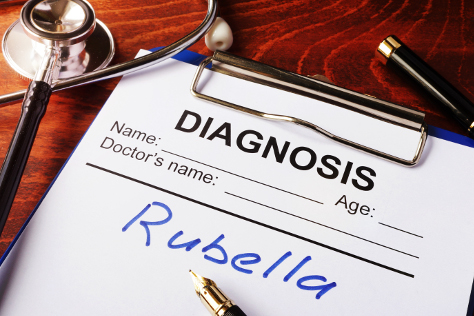What is rubella?
Rubella is a highly infectious viral disease. It's most common in childhood, when it's usually quite a mild illness – although cases have dropped dramatically since the introduction of the MMR (measles, mumps and rubella) vaccine in 1988. If a pregnant woman who doesn't have immunity to rubella comes into contact with the virus, though – especially during the first 12 weeks of pregnancy – the effects can be devastating on her unborn baby. Ideally, women planning a pregnancy should have their immunity status checked before conceiving.
Thankfully, cases of congenital rubella syndrome are very rare, with only four cases diagnosed in England and Wales in 2005 (the most recent year for which figures have been collated).
A baby affected by rubella in pregnancy is very likely to have congenital rubella syndrome. Ninety per cent of babies whose mothers (who are not immune) come into contact with rubella in the first three months of the pregnancy suffer damage as a result, and this can range from eye problems, to deafness, heart defects and brain damage amongst other organ damage. Some babies are miscarried or stillborn. This is why it's so important for as many children as possible to have the MMR vaccine. It's thought that at least 95% of the population needs to be vaccinated in order for serious diseases to be eradicated.

The rubella virus is airborne and comes from the coughs and sneezes of infected people.
Rubella is a notifiable disease under the Public Health (Infectious Diseases) Regulations 1988. This means that any doctor who diagnoses the infection must, by law, inform the local authority, to identify the source and try to stop it spreading.
What are the symptoms of Rubella?
Symptoms usually appear two to three weeks after coming into contact with the virus. Up to 50% of people who contract rubella have no symptoms and aren't even aware of the illness. Some people have early (known as 'prodromal') symptoms before the main signs appear. These can include a mild fever, conjunctivitis, sore throat, headache and streaming nose.
The tell-tale later symptoms are a reddish-pink rash and a fever (temperature of 38ºC or higher) with swollen glands behind the ears and in the neck. Aches and pains also occur in some children although these are less common.
What are the treatments and remedies of Rubella?
There's no specific treatment for rubella, which usually clears up within 7-10 days. Home treatment includes drinking plenty of fluids and controlling a fever and reducing aches and pains with paracetamol or ibuprofen. You should avoid contact with other people, especially pregnant women, for five days after the rash appears. Once you've had rubella, you are usually immune to it for life.
This guide
The information in this Bounty A-Z of Family Health is not a substitute for an examination, diagnosis or treatment by a doctor, midwife, health visitor or any other qualified health professional. If in doubt, always speak to a doctor.
Bounty will not be held responsible or liable for any injury, loss, damage, or illness, however this occurs or appears, after using the information given on this website and in particular the A-Z of Family Health.
Further help
For health advice and information 24 hours a day, 365 days a year, the NHS offers call and web services. You can also visit NHS websites for services, health information and health news at nhs.uk
- England – call 111 from any landline or mobile phone free of charge, or visit nhs.uk
- Scotland – call 111 from any landline or mobile phone free of charge, or visit nhs24.com
- Wales – call 0845 4647 , or visit nhsdirect.wales.nhs.uk
- Northern Ireland – visit hscni.net